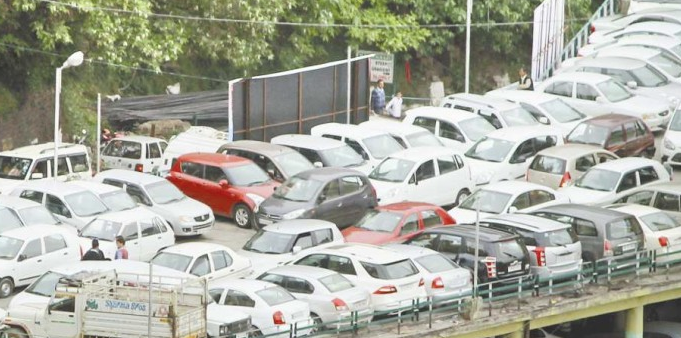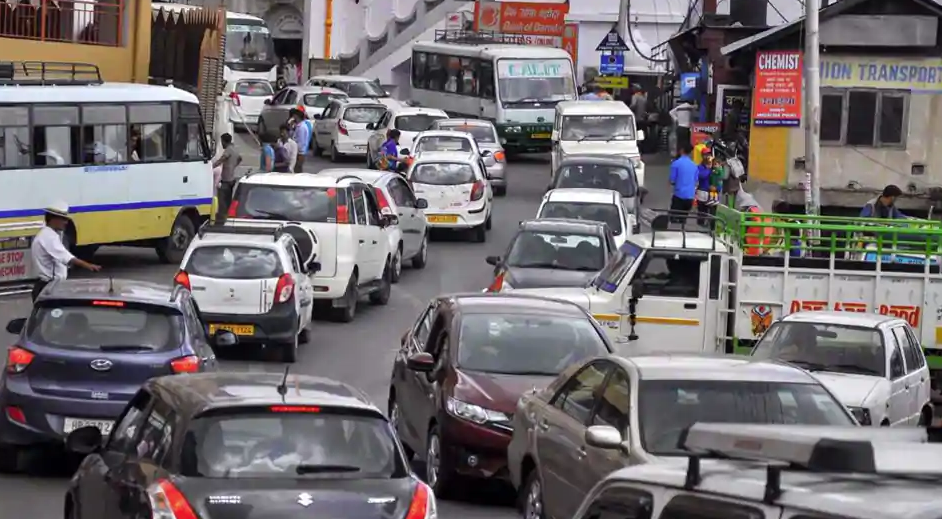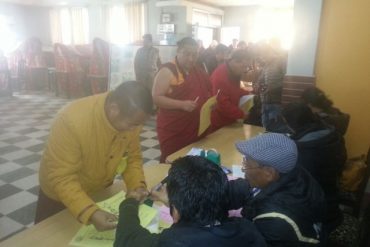City under siege readies to survive another Christmas – New Years deluge
Scenic when viewed from a distance, the seductive hill city scattered around majestic deodar and oak forests has a dark underbelly.
Driving on in its narrow roads is a motorist nightmare where the pedestrian has already been pushed over to walk in the drains.
Vehicles have sieged much of Shimla’s public spaces, often ruining a tourists holiday and making the life of the resident that much harder. The more built up parking space the civic authorities create, the more chronic the traffic jams become.
The romance that the city conjured about lover’s lanes, secluded picnic spots and well maintained parks is history. Much of the roads reserved only for pedestrians, including a large section of The Mall Road, has been overtaken by vehicular traffic.
Only a week ago, chief minister Jairam Thakur along with Kenichi Yokoyama, the country head of Asian Development Bank (ADB), inaugurated a new 13 storied parking.
Constructed with Rs 82 crore loan funds drawn from ADB for beautification and infrastructure improvement, the parking can accommodate 4 buses and 850 small vehicles. At Rs 9.60 lakh the space created for parking one vehicle is certainly way to expensive.
Shrinking public space for children, senior citizens, pedestrians
Expressing concern about using borrowed capital to promote private transport at the cost of public transport and shrinking public spaces for children, senior citizens and the pedestrian, city based architect planner Hitanshu Jishtu differs,“creating more parking space is not solving the traffic congestion problem. The higher the density of vehicles moving about over limited road space, the more it adds to the chaos.”
“With more and more public space getting used up for giving right of way to vehicular transport, nobody is even considering constructing playgrounds for children, parks and only pedestrian paths for senior citizens,” he adds.
Promoting private transport over public transport
Demand for parking outstrips many times over than what can be created or built. The Smart City Proposal of Shimla Municipal Corporation in 2017 estimated a need for 14,500 car parking slots. However, there were only 5791 slots available. Opening of the new parking facility and other small ones added, there are only about 7000 parking slots, less than half of what is needed.

For only 90 Km of road length that Shimla has for public transport purposes, the per car unit density is way to high. Tourist vehicles entering the city on weekends and holidays compound the problem.
Where residents and tourists like to walk about the city, only 16% of the motorable roads have footpaths. To encroach upon only pedestrian roads, the lawmakers ironically enacted ‘The Shimla Road Users & Pedestrians (Public Safety & Convenience) Act, 2007’ that opened up even some sections of The Mall Road for vehicles. VIPs and influential people were permitted to ply vehicles after being issued fee based passes for these restricted roads where no vehicle was allowed earlier.

Delhi based development consultant Anuradha Yagya, an alumna from School of Planning and Architecture in her paper ‘Making A Smart City In A Fragile Ecosystem: The Case of Shimla’ points out, “availability of public conveyance is inadequate with there being only 308 buses for public transport.” Share of public transport had dropped from 65% in 2005-06 to 49% by 2012.
To register a new vehicle it is now mandatory to declare under oath that the owner has parking space. Despite the restriction rule, vehicle ownership has risen by 23%. The 2012 Shimla Comprehensive Mobility Plan survey noted that the 18 Km circular road, the city’s main arterial road, on all sections was being used for on-street parking.
Walkers at the receiving end
Pedestrian traffic at the busy Sanjauli Chowk was of about 1 lakh people on a working day. Walkers were in danger at Chota Shimla, Kasumpati Chowk, Victory Tunnel and other junctions also.

Traffic volume of 39,914 vehicles crossing Victory Tunnel in a 16 hour day period was the highest. Average speed was 27 Km per hour that dropped to 2 Km per hour during peak hours. The baseline survey was done 6 years ago and the traffic volume has only gone up since then.
To contain the government vehicular traffic, Rajneesh Rana, a city based IT entrepreneur says, “a Uber/Ola type App can aggregate much of the government employee transport needs, which will drastically reduce the number of vehicles plying on the roads.”
“Even comfortable staff buses would be a more efficient transport mode to reduce traffic load on the roads,” adds Rana.
The district administration, soon after opening of the new mega parking, drew a new plan to contain traffic congestion for the year ender festive week. All tourist vehicles were to be denied entry beyond the parking point.
The hotel industry threw up a stink and the very next day the administration withdrew its order. With most hotels fully booked for the upcoming Christmas-NewYear bash, Shimla prepares to survive another deluge of swanky SUVs, cars and oversized buses.
As Editor, Ravinder Makhaik leads the team of media professionals at Hill Post.
In a career spanning over two decades through all formats of journalism in Electronic, Print and Online Media, he brings with him enough experience to steer this platform. He lives in Shimla.




82 lakh to house 850 small cars and nobody has questioned that? It looks like someone has had there hand in the piggy bank in Europe you would be looking at £994500 to build which in today’s exchange rate Rs 88676421.14. This is the cheapest rate in Europe and as you can see a vast amount cheaper then Himachal Predesh which in reality is impossible as labour costs and materials are so much cheaper then Europe. Also as much of the world is banning cars from city centres or have a program to faze this in why is India going in the opposite direction. My concrete and cars equals less forest cover and natural beauty which in turn has less tourist income. Shimla is one of the few hill stations that is connected by rail and these idiots build a expensive car park when they should have invested in the rail network and discourage tourists to come up by car. The intelligence of people in power are truly baffling unless they have there own interests at heart.